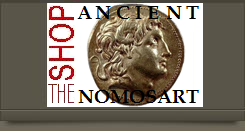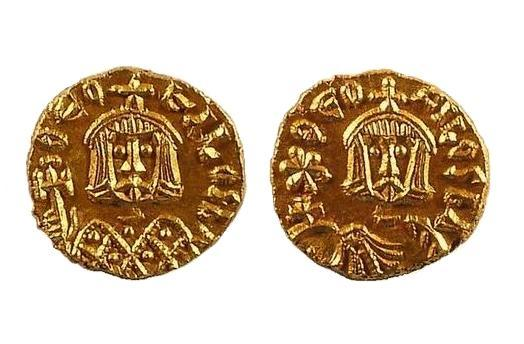
about ancient nomos
Ancient Nomos Art is a museum of galleries exhibiting ancient coins and ancient mint maps. The coin gallery displays the diverse art and history of hand-crafted ancient Greek, Roman, Byzantine, Persian and Medieval coinage. The ancient mints mapping gallery features Greek, Roman, Byzantine, Asia Minor and Medieval mint city regions and territories. Visitor's are welcome to explore, study and enjoy Ancient Nomos Art.

Byzantine, Roman – 829 AD
Theophilus
From Ancient Galleries

Obverse: Crowned half-length bust of Theophilus, wearing loros and holding cross.
Reverse: Crowned bust of Theophilus, wearing chlamys, holding globus cruciger.
LEGEND
Obv. ΘEO FILOS bA, Crowned half-length facing bust of Theophilus, wearing loros, holding globus cruciger. Rev. *ΘEO FILOS bA, Crowned half-length facing bust of Theophilus, wearing chlamys, holding globus cruciger; star at beginning of legend.
Theophilus became Emperor after the death of Michael II in 829 AD and reigned until 842 AD. His reign occurred during the pivotal events known as the 2nd iconoclastic controversy. The Emperor’s position was that of iconoclast, commonly known as a “destroyer of icons,” requiring him to enforce the imperial edict forbidding the veneration of sacred images. On the other hand, his new wife Theodora was an iconodule or “venerator of icons,” thus she disapproved of his religious policies. She was able to conceal her icon worship for the duration of his reign and was able to reverse the edict after his death. Ironically, the above gold tremissis is both iconic and exemplary. The above Byzantine gold coin exemplifies two major changes that developed in the art of coinage. The first change was the removal of the cross from the coins reverse, though two smaller crosses remain on the obverse and reverse. For nearly two centuries a large cross was the major reverse image, but now has changed to depicting a Byzantine style portrait of the Emperor’s ancestry, typically the Emperor’s son and perhaps successor. The second change was to be a new stylistic conception of portraiture. This new purely Byzantine conception of portraiture represents the Emperor’s bust in the disciplined art of linear line work. This new style of portraiture removed the previous vestiges of Roman realism and sculpted individual detail. The portrait is now a series of abstract lines. The only way to now differentiate the Emperor on his coins from the junior colleagues is by his larger size and smaller colleagues. Also by the clothing he wears and by the faint immature traces of facial hair on the youthful portraits. Only the Loros garment on the above coin signifies who is Emperor Theophilus. The tremissis denomination (and semissis) was virtually eliminated from the Byzantine world by the middle 8th century, struck for the last time under Leo III. Very rare ceremonial issues were struck in the east by Nicephorus I from 802 to 803 AD, while only the Syracuse mint in the west struck this rare denomination until the city lost its holy Roman status to the Arabs in 878 AD.
DOCUMENTATION
Value: Tremissis. Metal: AV Gold. Weight: 1.24 grams. Mint: Syracuse. Date: 829-830 AD.
Attribution: DOC III 20; Anastasi 546 (legends variety); Spahr 419; SB 1679.
Legend, Documentation and Attribution
